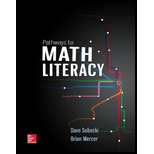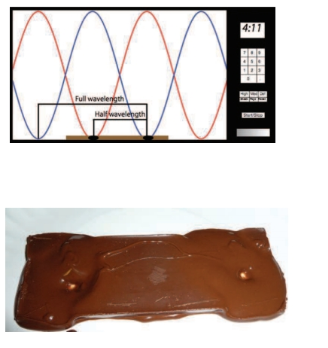
A fun fact: you can use a microwave oven and a bar of chocolate to measure the speed of light. Really! Microwaves are electromagnetic waves, just like visible light. The difference is the wavelength of these waves: For visible light, the wavelengths are in the neighborhood of
m, while microwaves are close to
m. Basically, microwaves emitted in an oven make molecules in food vibrate, which causes heat. The first places to heat up are separated by half of a wavelength, so by using something that starts to melt visibly in certain spots, we can calculate the wavelength. We can then use that to calculate the speed of light, which I think we can all agree is pretty darn cool.
If your teacher is unusually adventurous, he or she might bring in a microwave and chocolate bars, in which case you can perform the experiment on your own. Start with around 20 seconds, and make sure you take out the carousel: the chocolate has to stay stationary. (And now you know why a lot of microwaves have a carousel: food heats more thoroughly at the spots corresponding to half of the wavelength.)

If no microwave and chocolate is available, I did the experiment at home and took a picture for you, which is reproduced here. It’s a life-size scale, so you can measure the distance between the melted spots with a ruler.
Find the error and relative error in your estimate as a decimal, and as a percentage. (If you need a refresher, relative difference was introduced in Lesson 2-4.) If your answer is WAY off, you might want to check the microwave to see if the frequency is different from 2.45 GHz.
Want to see the full answer?
Check out a sample textbook solution
Chapter 4 Solutions
Pathways to Math Literacy (Loose Leaf)
- Answer questions 8.2.9 and 8.2.10 respectivelyarrow_forwardAnswer questions 8.3.5 and 8.3.6 respectivelyarrow_forward8.6.4 Consider the test on the compressive strength of concrete described in Exercise 8.2.9. Compute a 90% prediction interval on the next specimen of concrete tested. 8.6.5 . SS Consider the fuel rod enrichment data described in Exercise 8.2.11. Compute a 90% prediction interval on the enrichment of the next rod tested. Compare the length of the prediction interval with the length of the 99% CI on the population mean.arrow_forward
- Answer questions 8S10 and 8S11 respectively.arrow_forward8.4.6 Information on a packet of seeds claims that 93% of them will germinate. Of the 200 seeds that were planted, only 180 germinated. a. Find a 95% confidence interval for the true proportion of seeds that germinate based on this sample. b. Does this seem to provide evidence that the claim is wrong? 8.6.1 Consider the tire-testing data described in Exercise 8.2.3. Compute a 95% prediction interval on the life of the next tire of this type tested under conditions that are similar to those employed in the original test. Compare the length of the prediction interval with the length of the 95% CI on the population mean.arrow_forwardPlease solve 14 and 15arrow_forward
- 1. Consider the following system of equations: x13x2 + 4x3 - 5x4 = 7 -2x13x2 + x3 - 6x4 = 7 x16x213x3 - 21x4 = 28 a) Solve the system. Write your solution in parametric and vector form. b) What is a geometric description of the solution. 7 c) Is v = 7 in the span of the set S= [28. 1 HE 3 -5 3 ·6 ? If it is, write v 6 as a linear combination of the vectors in S. Justify. d) How many solutions are there to the associated homogeneous system for the system above? Justify. e) Let A be the coefficient matrix from the system above. Find the set of all solutions to Ax = 0. f) Is there a solution to Ax=b for all b in R³? Justify.arrow_forwardAnswer questions 8.3.1 and 8.3.2 respectivelyarrow_forward8.2.7 The brightness of a television picture tube can be evaluated by measuring the amount of current required to achieve a particular brightness level. A sample of 10 tubes results in x = 317.2 and s = 15.7. Find (in microamps) a 99% confidence interval on mean current required. State any necessary assumptions about the underlying distribution of the data. 8.2.8 An article in the Journal of Composite Materials (December 1989, Vol. 23(12), pp. 1200–1215) describes the effect of delamination on the natural frequency of beams made from composite laminates. Five such delaminated beams were subjected to loads, and the resulting frequencies (in hertz) were as follows: 230.66, 233.05, 232.58, 229.48, 232.58 Check the assumption of normality in the population. Calculate a 90% two-sided confidence interval on mean natural frequency.arrow_forward
- 4. Suppose that A is made up of 5 column vectors in R³, and suppose that the rank(A)=3. a. How many solutions are there to Ax=0? Justify. b. What is a geometric description for the nullspace(A)? Justify. c. Do the column vectors of A span R³? Justify. d. Is A invertible? Justify.arrow_forward8.2.5 An article in Obesity Research [“Impaired Pressure Natriuresis in Obese Youths” (2003, Vol. 11, pp. 745–751)] described a study in which all meals were provided for 14 lean boys for three days followed by one stress test (with a video-game task). The average systolic blood pressure (SBP) during the test was 118.3 mm HG with a standard deviation of 9.9 mm HG. Construct a 99% one-sided upper confidence interval for mean SBP. 8.2.6 An article in Medicine and Science in Sports and Exercise [“Maximal Leg-Strength Training Improves Cycling Economy in Previously Untrained Men” (2005, Vol. 37, pp. 131–136)] studied cycling performance before and after 8 weeks of leg-strength training. Seven previously untrained males performed leg-strength training 3 days per week for 8 weeks (with four sets of five replications at 85% of one repetition maximum). Peak power during incremental cycling increased to a mean of 315 watts with a standard deviation of 16 watts. Construct a 95% confidence…arrow_forward3. Suppose that A is 5 x 5 and rank(A)=4. Use this information to answer the following. a. Give a geometric description of nullspace(A). Justify. b. Is A invertible? Justify. c. Give a geometric description of the span of the column vectors of A. What space are the column vectors of A in? Justify. d. What is determinant of A? Justify.arrow_forward
 Elementary Geometry For College Students, 7eGeometryISBN:9781337614085Author:Alexander, Daniel C.; Koeberlein, Geralyn M.Publisher:Cengage,
Elementary Geometry For College Students, 7eGeometryISBN:9781337614085Author:Alexander, Daniel C.; Koeberlein, Geralyn M.Publisher:Cengage, Elementary Geometry for College StudentsGeometryISBN:9781285195698Author:Daniel C. Alexander, Geralyn M. KoeberleinPublisher:Cengage Learning
Elementary Geometry for College StudentsGeometryISBN:9781285195698Author:Daniel C. Alexander, Geralyn M. KoeberleinPublisher:Cengage Learning Trigonometry (MindTap Course List)TrigonometryISBN:9781305652224Author:Charles P. McKeague, Mark D. TurnerPublisher:Cengage Learning
Trigonometry (MindTap Course List)TrigonometryISBN:9781305652224Author:Charles P. McKeague, Mark D. TurnerPublisher:Cengage Learning- Algebra & Trigonometry with Analytic GeometryAlgebraISBN:9781133382119Author:SwokowskiPublisher:Cengage
 Trigonometry (MindTap Course List)TrigonometryISBN:9781337278461Author:Ron LarsonPublisher:Cengage Learning
Trigonometry (MindTap Course List)TrigonometryISBN:9781337278461Author:Ron LarsonPublisher:Cengage Learning Holt Mcdougal Larson Pre-algebra: Student Edition...AlgebraISBN:9780547587776Author:HOLT MCDOUGALPublisher:HOLT MCDOUGAL
Holt Mcdougal Larson Pre-algebra: Student Edition...AlgebraISBN:9780547587776Author:HOLT MCDOUGALPublisher:HOLT MCDOUGAL





